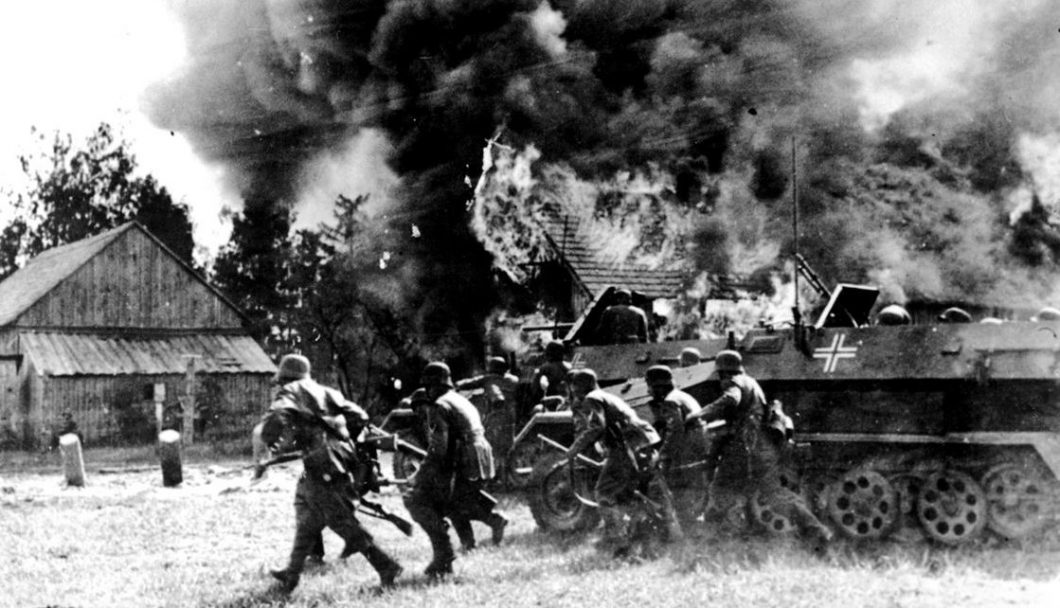Wokery likes to make morality plays out of the past, but the past refuses to cooperate.
Second World War: A “Bloody Laboratory,” and a Foreordained Result
Is there a greater living military historian than Victor Davis Hanson? I am not just speaking of his prowess as a military historian of World War II, for there are ample competitors and Hanson draws on them throughout his marvelous new book. Rather, I am speaking of him as a historian of military affairs—ancient and modern—who can switch from discussing Italy’s Mediterranean strategy in 1940 to the ancient Greeks and their seaborne strategy, to the siege of Leningrad and the Muslim siege of Constantinople, to the connections between the D-Day invasion of June 6, 1944 and Xerxes’ expeditionary invasion of Greece. Seamlessly, one senses the erudition of a scholar at the height of his craft with an original way of casting the history of the Second World War.
The Second World Wars: How the First Global Conflict Was Fought and Won argues that it was a war unlike any before (and hopefully) any since. Military engagements occurred on every sea and on every continent with the exception of Antarctica. It was fought on land, sea, air and with firepower and on a scale never before seen in human history. Hanson recounts how it began and why, never failing to blame the British appeasers, American isolationists, and Soviet collaborators for their part in bringing on the conflict. In each case, not singly, but working in unison, all the great powers, not just the aggressors, were responsible for the unfolding tragedy.
Hanson catalogues the weapons employed and offers statistics on the death toll (settling on 60 million, about the number Gerhard Weinberg estimated in his global history of World War II). He documents the decisions, and the indecisions, that turned it into a truly global conflict. And it was, as he writes, “a preventable conflict” in which “sixty million people had perished to confirm that the United States, the Soviet Union and Great Britain were far stronger than the fascist powers of Germany, Italy and Japan after all—a fact that should have been self-evident and in no need of such a bloody laboratory.”
Most important, the author carefully elucidates what the military commanders and political leaders did and criticizes them for their failure to take grand strategy—the balancing of means and ends—into account. He is particularly hard, of course, on Adolf Hitler and Josef Stalin, but also draws our attention to the Anglo-American decision to invade Italy, a costly operation not concluded by the end of the war. The Italian campaign could have been foregone in favor of occupying parts of Italy and using its bases as launching points for invading southeastern Europe or as airfields for campaigns against the Balkans or southern Germany and Austria.
The lack of strategic prowess is quite obvious in the case of Germany and Japan. Hitler’s ideological predilections got in the way of clear thinking. He also violated the law against the accumulation of enemies with his decision to turn against the Soviet Union in 1941, rather than to wait a few years when, with improved armor and aircraft, he might have been better served. Likewise he erred in bailing out his Italian ally in North Africa while starving Erwin Rommel of the forces necessary to defeat the British in Egypt and to invade the Levant and take Suez.
All was due to his obsessive fantasizing—the ease by which he believed the Russians could be defeated as well as his pronounced hatred of Western democracies. The strategic blind spots of Hitler, and his general staff, served no greater purpose than to get Germany embroiled in a global conflict it could not win. Hitler’s last decision—to declare war on the United States—sealed his fate as American industry and airpower proved decisive to Nazi Germany’s defeat.
So, too with Japan, whose decision to attack Pearl Harbor and to expand across the Pacific, when most of its army strength was fighting in China, also stemmed from hubris, a Greek term which, strangely, makes no appearance in Hanson’s discussion of strategy. Japan lacked the resources to confront the United States and Great Britain, even though the strategy bore fruit initially. Japan’s loss of four fleet aircraft carriers at the June 1942 Battle of Midway, and with America’s arsenal of democracy capable of cranking out a profusion of carriers, battleships, cruisers, and merchant ships (in spite of the loss of three aircraft carriers during the Pearl Harbor attack) forced Japan on the defensive for the remainder of the war.
Wehrmacht at a Huge Disadvantage
Hanson shows the progress of the war through a unique interpretive lens, focusing first on the war on water, air, and land, and then turning his attention to the leaders, commanders, workers, and the war dead, including a discussion of the Holocaust. In each chapter he concentrates on the main combatants and their use of all measures of warfare. He makes plain in the chapters on sea and air power that the Axis powers could not win.
Germany never developed a four-engine bomber; neither Germany nor Italy produced an aircraft carrier; and the expensive battleships and cruisers the Germans did launch—the Bismarck and the Tirpitz—took resources away from U-boats and developing carriers and were both sunk (as were most major battleships). Similarly, Germany never developed a strategic bomber and relied on outdated two-engine bombers in the Battle of Britain and in ground support on the Russian front. Japan had more success attacking ships with kamikaze pilots (who sunk 346 vessels) than with their skilled and well-trained naval aviators, whom they could not replace.
On the Allied side, the Soviets did not have to develop a strategic bombing force as the United States and Great Britain handled the air bombardment of German industries and cities (a task that cost over 60,000 air crew dead, and a sacrifice that Stalin never appreciated), which freed them up to invest in tanks and artillery in the costly defeat of the German invaders.
At one point Hanson reminds the reader that Germany relied on two fighters for the majority of the war—the Messerschmitt and Focke-Wulf—while the Americans developed a catalogue of fighters, the best of them the P-51 Mustang, which was powered by a Rolls Royce Merlin engine. Of course, the United States also developed the B-29 bomber, the most expensive weapon of the war, which allowed it to pummel Japan from January 1945 until the atomic bombings in August 1945.
Even on the ground, the Wehrmacht was at a huge disadvantage after the fall of France, relying as it did on light armored tanks, with too few mechanized trucks to transport troops (they were carried about in horses and carts much of the time). The Germans developed the Tiger and Panther tanks which, if they could have been mass-produced, would have matched any land weapon employed against them. But only 500 Panthers were produced, and they were vulnerable to the P-47 Thunderbolt tank-killers that roamed freely in France and western Europe after D-Day. The Soviets, meanwhile, their industry secure from German air attacks beyond the Urals, produced a staggering 500,000 trucks and over half a million tanks—not to mention the war materiel they got as part of Lend Lease aid from the Allies—including the superb T-34 which Russia relied on for the entirety of the war.
The bottom line of this analysis is that the Axis powers never could have won; the Axis leaders’ decisions, as explained by Hanson, make this clear. But an economic calculus makes the inevitability of the outcome even clearer. In 1939, the United States and the other Allied nations had a Gross National Product of $1.6 trillion compared to an Axis GNP of $685 billion. At the high point of wartime production, the Allies reached $2.4 trillion (a staggering $1.5 trillion of which was produced by the United States) while the Axis had risen to $895 billion. Do the math and you can see the futility of a war that was prolonged only by the tenacity of German and Japanese resistance and the skill of the soldiers, particularly the Wehrmacht.
Debates on the Homefront
What would make a good companion to Hanson’s book is World War II: Core Documents edited by Jennifer Keene. Keene, a professor of history at Chapman University and an expert on the soldier’s experience in the First World War, has put together a collection of documents from the Second World War that has been published by the John Ashbrook Center at Ashland University. This is the newest of Ashbrook’s primary source readers, a series that will eventually cover U.S. history in its entirety. The series is most useful for teachers and students as it will make available, at limited cost, all of the major primary sources in the field. I teach in Ashland’s Master’s in History and Government program, which prides itself on using documents and primary sources, and will be using several of these volumes myself.
Half of World War II: Core Documents covers the debate over isolationism in the 1930s, conflicts over Lend Lease at home, and the development of the arsenal of democracy. The second half covers the war, mostly focused on domestic issues—the relocation and internment of Japanese Americans, racial issues, and debates over the Holocaust—on the American home front. The volume contains only one document concerning the relationships among the Allied countries during the war, the Potsdam Declaration. I would have liked to see more of the debates between Stalin, Franklin Roosevelt, and Winston Churchill at the Teheran and Yalta conferences as these elucidate what Hanson shows: a united front (sort of) between the Allied powers which was sorely lacking on the side of the Axis powers. What Keene has produced is a useful compendium on the war’s domestic issues that would nicely complement Hanson’s military history in an undergraduate course on World War II.
That conflict is and remains the central global war in all of history, the scale and scope of which influenced the rest of the 20th century. Hanson’s book reveals the importance of remembering its lessons and legacies, as well as the details of the destructive capabilities of industrialized states fighting war in the modern era. As its shadow fades from our view, we must be reminded of the sacrifice and duties borne by a generation of people the world over to defeat the evils of fascism and totalitarianism, even though this produced another worldwide conflict with a longer-lived totalitarian nemesis under the shadow of nuclear destruction. As Hanson shows, World War II brought surprises, engendered new weapons, and brought about coalitions unthinkable just a few years before it started. It reveals all of the hubris and honor of any conflict and the tragedy and trauma that might haunt us still, lest we forget how it happened, what was lost, and what was gained.



